How to Develop a Successful PR Strategy In 2021 (Guide)
The way to develop and launch a successful PR strategy has changed. In this guide, you’re going to learn how strategic PR can help your business grow in 2021. More specifically, Read More...
What makes a good media pitch?
Is it…?
These 8 media pitch examples will answer this question.
So, if you really want to know how to write media pitches that get press coverage, this guide is a must-read.
The obvious question we need to answer before moving on to the email templates I have for you is, “What is a media pitch?”
In other words, why should someone consider using media pitching and start cold-emailing people as part of their marketing strategy?
Before answering that question, let’s consider this:
As most top-tier publishers receive between 50 and 500 pitches per week, it’s all too easy for your email pitch to get lost in the noise.
It’s crazy, right?
Imagine if you had to read somewhere between 50 and 500 email pitches—mostly from total strangers—every single week.
Assuming you do read some of them, how would you pick the ones to reply to and spend more time examining?
To put it plainly, what makes a cold email stand out from the noise and have a chance of further exploration?
To begin with, media pitching isn’t a new thing.
As you can see from the below table, the interest for the term “media pitch” has remained fairly steady for the last five years.


So, before delving any further, let’s try to give a proper definition to media pitching.
Media pitching is the process of promoting (pitching) information about your products and services to journalists, bloggers and people with influence in your industry, with the purpose of getting press coverage, brand mentions and extra exposure for your business.
Now, you may be wondering: why is this important?
The answer is simple: media coverage from the right publication can really help your startup or established business raise awareness and grow.
As TechCrunch states in its article “Finding the right reporter to cover your startup”…


You’ve read correctly.
TechCrunch—a target publication for most tech startups—stresses the importance of pitching the right publication and the right reporter in order to see your article, story, content piece or product get published.
Rest assured that if you do pitch the right reporter or publication and get press coverage, your whole business can be transformed.
There are many examples of companies that have been featured in publications such as TechCrunch, Forbes, Business Insider, Mashable and WIRED, and witnessed a significant uplift in their traffic or sales.
So, what makes a good media pitch?
We’ll try to answer that question through a list of 8 media pitch examples—all of which have been tried and tested by people trying to promote their small businesses, new products or articles to the most prolific publications online.
According to a survey by content marketing agency Fractl on 1,300 top-tier media publishers, only 52% of these publishers believe the pitches they receive are somehow valuable.
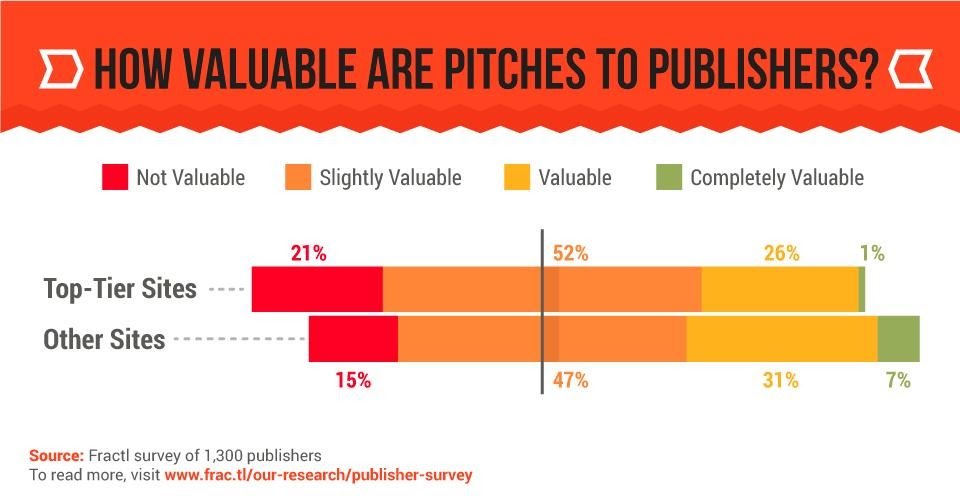

That leaves us with 48% of top-tier publications believing that they don’t get any value out of the media pitches they receive.
This could also explain why most PR pitches go unnoticed.
However, if we look closely at the data from this survey, we’ll come to a significant realization:
If we somehow manage to add value, we have a fair chance of receiving a reply.
One of the best ways to add value is by giving the person we’re trying to reach out to (e.g. journalist, influencer, blogger) something they can’t find elsewhere.
As you might have guessed, that “something” is data.
Here’s our first media pitch example:








New Study on Technology Adoption: Data from (x) Countries
Hey {first_name},
I’ve been looking for a few folks who have covered the topic of technology adoption and found your awesome post on {website_name}.
Loved the way you said [Insert Article Summary].
To conduct the study, we’ve used [technology for retrieving and analyzing data].
Some of the main findings of the study include:
You can take a look here:
example.com/technology-adoption
Could you share your feedback with us when you do?
Thanks,
{Name}
After finishing up with our media pitch, we insert it into Respona’s editor and let Respona grade the tool based on four different parameters.
These parameters are:
Here’s our email in Respona’s editor:
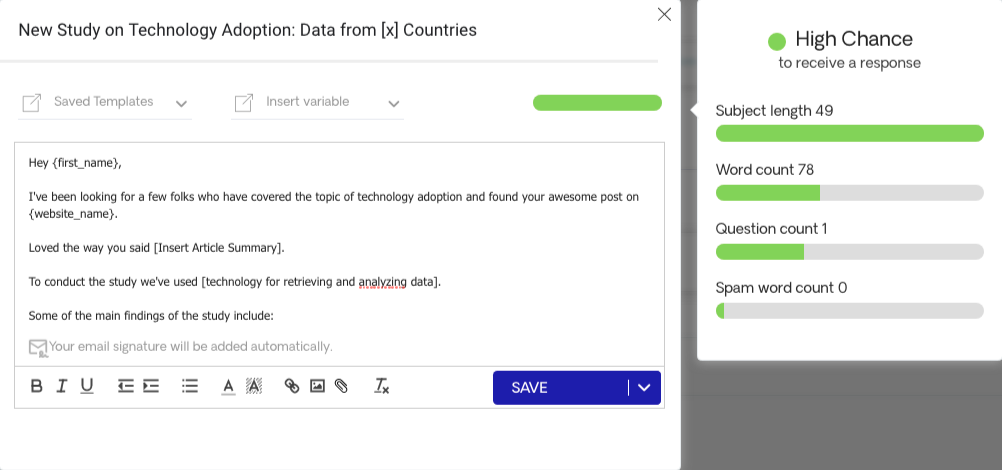

The fields with {} are what we call “Variables”.
Here are some of the default Variables that Respona has.


Based on the PR software you’re using, before sending your email, you need to personalize it by adding relevant information, such as adding a quick article summary that outlines your prospect’s article.
As we mentioned earlier, personalization in media pitching is very important, so mentioning a relevant content piece or recent article that your prospect has previously published can definitely help you get a positive reply. Additionally, including a unique email signature will help put a human face to the pitch and further personalize your message.
Why we like it: It adds value right away and thus has a good chance of getting a reply.
Ideal for: SaaS startups that have access to data and conduct their own studies.
Tools to use: Respona
What to pay attention to: Reach out ONLY to people who’ve expressed interest in data and studies in your field of expertise.
Let’s face it.
Everyone wants to feel valuable.
Everyone wants to feel like they contribute to helping someone find a solution to a problem they may have or to inspire someone to change their life.
This is why reaching out to someone and thanking them for the help is more likely to result in them reading your message.
Of course, it’s one thing to read an email and another to actually send a reply.
Nevertheless, this type of media pitching is great if you’re trying to build relationships with journalists, bloggers and influencers.








Thanks for the help
Hey {first_name},
{Name} here from {Company}.
I’ve been following your work for {Time Period} now.
You’re among the people with the biggest impact on me and my business.
“[Insert Quote]”
I keep this phrase in mind every time {Related Story} happens.
For all this, I’d like to say thank you!
Keep inspiring us with your stories and articles.
Thanks,
{Name}
Why we like it: This type of pitch works because it helps your prospect feel valuable through their work.
Ideal for: Small businesses and solopreneurs reaching out to influencers in their niche who had an impact on them.
Tools to use: Respona
What to pay attention to: Don’t overdo it with praising your prospect for their help—always try to be genuine.
Nobody wants to see typos in their published work.
If you think of large publications or popular journalists who publish their articles in publications such as TechCrunch, Forbes and Mashable, typos are even more important.
Even though most publications have an army of editors and proofreaders making sure there are no mistakes slipping through the cracks, there still may be some that go unnoticed.
This is what makes finding those mistakes and pointing them out even more effective.








Typo in your (Topic) article
Hi {first_name},
[Your Name] here with [Company Name]. Respect your reporting a ton, love everything you put out.
Just finished reading your [Topic] article. It was interesting to learn [Insert Article Summary].
Noticed a couple of typos and thought I should reach out (it’s my OCD kicking in):
Looking forward to your next story. What article are you working on next?
Cheers!
{Name}
Note that the [Topic] and [Insert Article Summary] are personalization variables that you can edit and add to in the last step of setting up your email sequence with Respona.
Those variables are different than those you can add while in the “Create a sequence” stage.
For example, to add your prospect’s first name with Respona, all you need to do is move your cursor over the area where you want to insert the first name of your media prospect.
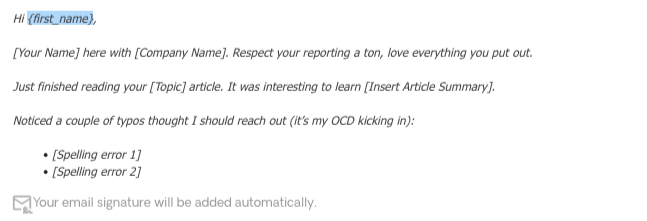

Click on “Insert variable”.
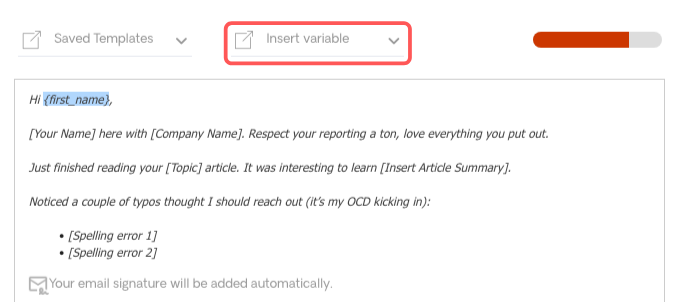

Next, choose the variable you want to add.
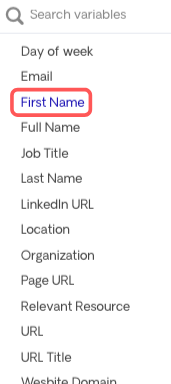

When you do, you’ll notice this variable is added to your email.
Variables are particularly useful for mass email campaigns, as they add an extra personalized touch to your emails.
Why we like it: No one wants to have typos or grammar mistakes in their work—this is why this tactic is so powerful.
Ideal for: Small businesses and solopreneurs reaching out to bloggers who’re publishing long-form pieces and most likely don’t have an editor in their team.
Tools to use: Grammarly/Respona
What to pay attention to: Don’t try to point out the mistake like you’re perfect—try to be modest about it and show your genuine interest in the prospect’s work.
As a business, you want to be present in every conversation that happens in your industry that could help you raise awareness about your products and services.
In the same vein, when someone is talking about something where your business is topically relevant, it’s essential that you’re present and mentioned.
In all such cases, you should be able to reach out to prospects and ask them to include you in their blog posts or articles.
Before discussing how you can do that, let me first share with you how you can uncover such opportunities.
To do so, open Respona and select “Opportunities” from the top menu.


Create a new Opportunity.


Then, start setting up your opportunity.
Since we’re going to carry out this process automatically, choose “Automation” in the window that pops up.


This way, Respona will bring such opportunities right to your door and at the frequency you want.
Next, you need to adjust the parameters (settings) for your opportunities.
Your settings need to be as follows:


Next, you need to set the keywords that will trigger your opportunities.
Even though you can be broad with your targeting, we’ve found that the more specific you get, the better.
Your search operator should look like this:


To make this a bit clearer, let’s use an example for Respona’s own site.
One of the content pieces we published recently is about PR outreach.
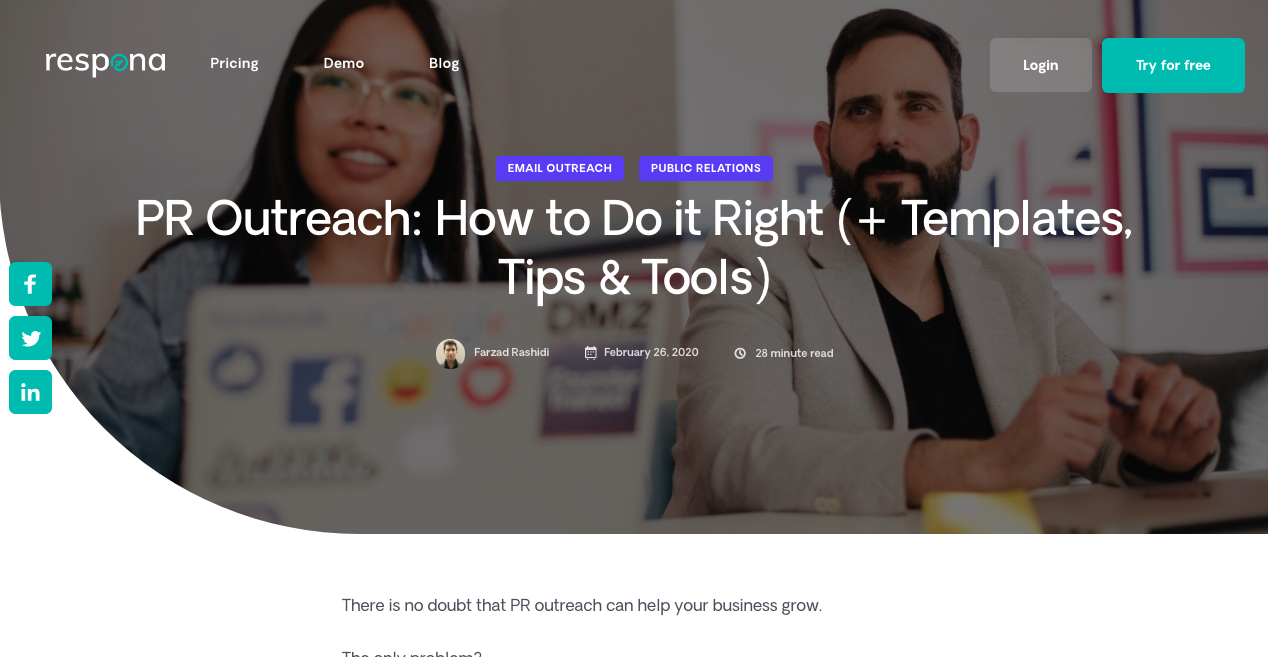

This is a post with over 6,000 words, discussing everything someone needs to know about PR outreach.
As you might have guessed, the target keyword in this case is “PR outreach”.
Thus, it would make sense for us to identify blog posts or news stories online that talk about PR outreach and don’t mention our product or resources.
The search operator we’d use in this case to identify such opportunities through Respona’s Opportunities feature would be the following:


Of course, we can also include more relevant keywords and phrases besides “PR outreach”.
One last thing to do before moving forward is to change the Source from “News” to “Web Search”, since we want to get opportunities from all around the web and not just from news sites.


This way, we’ll get opportunities from all around the web that include the term “PR outreach” but not “Respona”.
When we’re ready, we can click “Continue” and then, once we make sure everything is as it should be, “Create”.
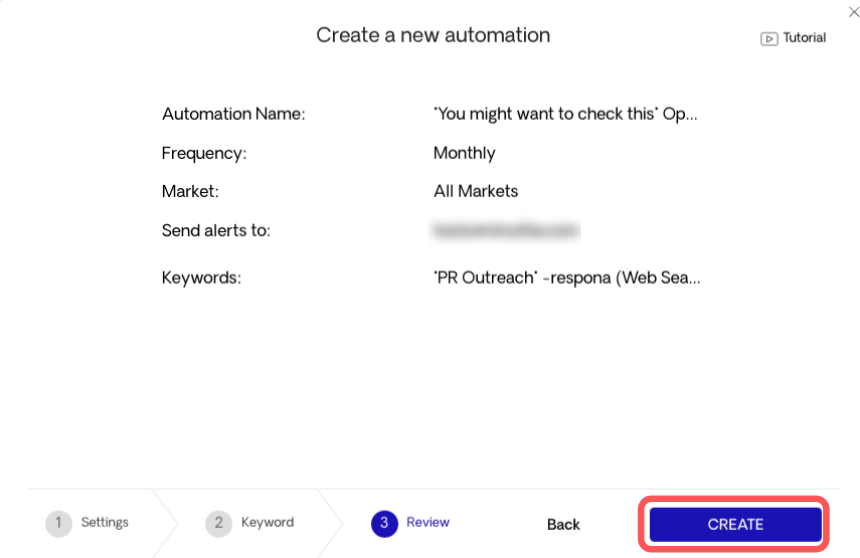

Here’s the email you can send to your media contacts.








You might want to check this
Hey {first_name},
My name is {Name} and I’m a {Role} at {Company Name}—{Something about the company}.
I was reading your article {Page URL} and found your points interesting.
This is the fact that [Insert article summary or interesting point].
We happen to have a resource that talks about {topic} and I’d really appreciate it if you could take a look.
You can find it at the following link:
{Relevant Resource}
If you find it useful, could you please link back to it through your website?
This will help any visitors interested in learning more about {topic} to be able to directly visit our website.
Let me know what you think!
Thanks,
{Name}
Why we like it: No one wants to miss things—this is why this tactic works so well.
Ideal for: Small businesses and SaaS startups looking for ways to constantly get mentions and earn backlinks for their website.
Tools to use: Respona’s Opportunities
What to pay attention to: You have to be really relevant and make sure that the person who wrote the article or blog post is likely still unaware of the content piece you’re trying to pitch.
Contrary to popular opinion, infographics still work.
In fact, the interest for infographics worldwide seems to have remained steady for the past five years.


This means that people are still looking for ways to create beautiful infographics that will get them press coverage, brand mentions and backlinks.
This explains why infographics are still part of the PR strategy for many companies around the world.
To create a beautiful infographic, you need two things:
To find high-quality data, you need to conduct research or rely on your own data set—if your company collects and analyzes data.
You also need to ensure that the journalists, bloggers or influencers you’re reaching out to are actually suitable for and interested in the content of your infographic.
In other words, your pitch has to be both well-researched and relevant.
Here’s the first version I have for you. (This is part of Respona’s ready-to-use templates.)








Infographic for your (Topic) Post
Hi {first_name},
Just finished reading your [Topic] article. Thanks for the awesome post! Shared with our team over here at [Your Company Name].
Loved the way you said [Insert Article Summary].
We’ve actually written a few in-depth articles about [Topic] in the past, and our design team has put together a really neat infographic to go along with it!
Let me know if you want to take a look!
Thanks,
{Name}
Here’s how the email looks in Respona’s editor:
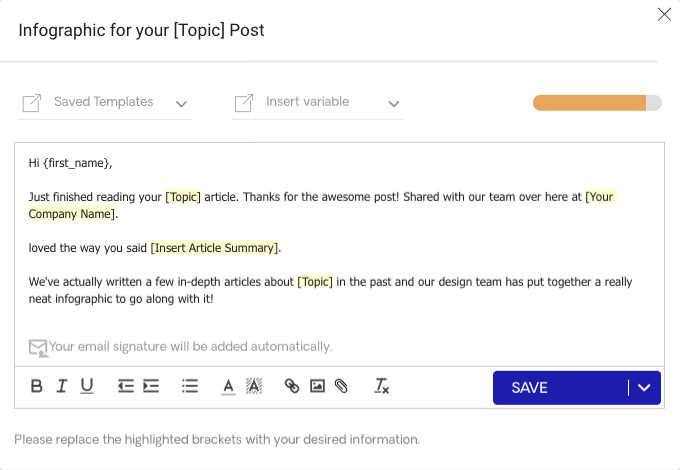

Note: To gain access to the complete sequence, be sure to sign up for a 14-day free trial.
Why we like it: Infographics still work!
Ideal for: SaaS startups with good design capabilities and research teams that are able to combine data from various data sources. (Also ideal for businesses that want to build backlinks, as this type of content usually attracts many links from external sites.)
Tools to use: Visme/Respona
What to pay attention to: Your design has to be solid, but the data itself has to be valuable as well. The combination of the two can get your infographic published on major publications.
This is the second version of pitching infographics to get media coverage.
The difference between this and the previous one is that this is better for companies that have already created a couple of infographics in the past.
Once again, this media pitch template is from Respona.
The subject line remains the same, while the body text is slightly different.








Infographic for your (Topic) Post
Hi {first_name},
[Your Name] here with [Your Company Name] :)
Just finished reading your [Topic] article. Thanks for the awesome post! Shared with our team at [Your Company Name]. Loved the way you said [Insert Article Summary].
I wanted to have our design team create a custom infographic for this article, on the house. My team and I at [Your Company Name] have taken on an assignment to find our favorite blog posts and create visuals to better inform your audience.
I’m attaching a preview of a couple of infographics we’ve done in the past.
Let me know if you’re interested?
Thanks,
{Name}
Here’s how this email template looks in Respona’s editor.


Why we like it: Infographics still work!
Ideal for: SaaS startups with good design capabilities and research teams that are able to combine data from various data sources. (Also ideal for businesses that want to build backlinks, as this type of content usually attracts many links from external sites.)
Tools to use: Visme/Respona
What to pay attention to: Your design has to be solid, but the data itself has to be valuable as well. The combination of the two can get your infographic published on major publications.
The truth is that everyone’s seeking exclusivity.
Why?
Four words: Fear of Missing Out (FOMO).
People want access to exclusive information because of a powerful psychological principle called FOMO.
So, when you have exclusive information about something (e.g. a product launch), you can use this type of media pitch to raise even more awareness about your new product or service.
Instead of a template, for this type of media pitch, we’ll examine an email sent by Jason L. Baptiste to a TechCrunch journalist prior to his startup’s launch.


This is a press release that was sent almost ten years ago.
You could argue that people don’t send press releases anymore.
For the most part, you’d be right.
However, if you…
… Then you have a decent chance of getting a response and starting a conversation.
Remember though: the information you provide and the person you’re reaching out to should be truly relevant.
The timeframe for someone to take action should also be as short as possible.
Thus, in the first paragraph of his email pitch, Jason L. Baptiste says:
“Launching PadPressed tomorrow…”
Not next week or next month, but tomorrow.
That leaves his prospect with a really short timeframe to take action.
In other words, it creates urgency and makes it difficult for the recipient of the email not to respond.
One pro-tip here is this:
Try to connect with your prospect on LinkedIn and Twitter a couple of weeks before you send your email.
Interact with their LinkedIn updates and Tweets and try to establish a relationship before reaching out to them.
If used correctly, this tactic can be really powerful.
Why we like it: It can be a great way to get some early traction and establish some media relationships that you can leverage later on.
Ideal for: Pre-launch startups that need to get some media coverage.
Tools to use: Respona
What to pay attention to: Be sure that the person you’re reaching out to has a genuine interest in what you’re offering as exclusive information.
This is a great way to get your product or service listed in list posts and comparison guides by bloggers and industry journalists.
Here’s how it works.
First, you need to create a list of words and phrases that people use to describe your product.
For example, let’s assume you have an online corporate training software tool that helps people create and sell online courses from their own websites.
Some of the phrases people likely use to search for your product are:
You can then combine these terms with phrases that are often used in list posts and comparison guides.
Such phrases are:
The above words and phrases are called search operators.
Combining them with the words/phrases that people use to search for your product will give you a search query.
For example, for the term “corporate training platform”, we’d have:
You can then use Respona’s search engine to find opportunities around these search queries.
To do that, you need to create a new content-based campaign with Respona.
Then, insert your opportunities one by one and, based on what kind of media coverage you’re looking for (e.g. podcasts, news stories), set the filter accordingly.
In our example, we’re not interested in a particular type of content format and thus have selected “Web Search” as our filtering option.


In a few seconds, Respona will return a list of high-quality and relevant results based on your search query.
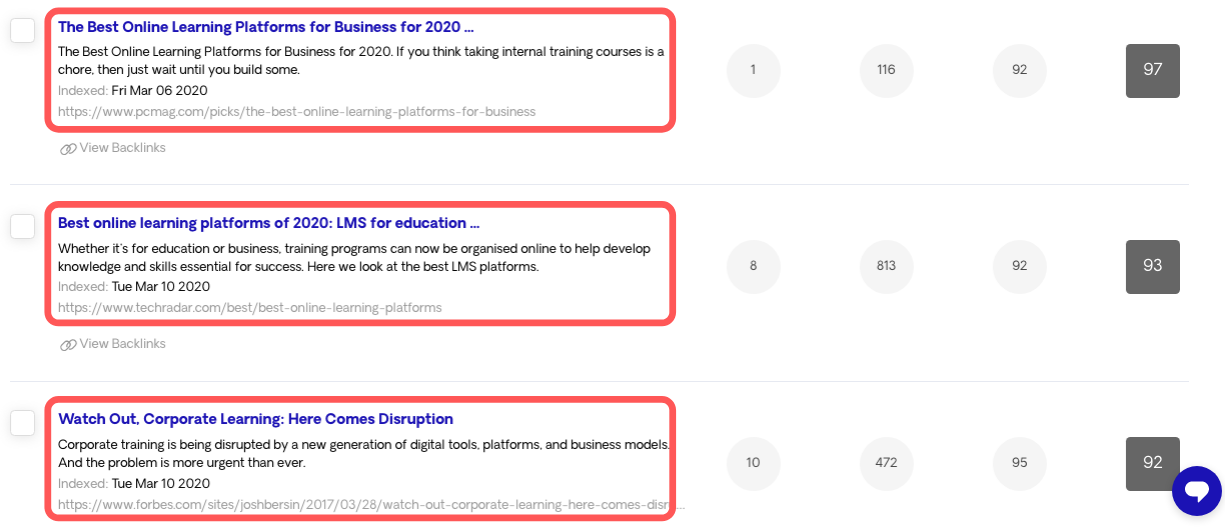

From there, it’s simply a matter of narrowing down the best prospects and sending a relevant pitch.
Here’s the email template you can use.








You missed one
Hello {first_name},
I wanted to quickly show my appreciation for your {url_title} list post: {url}
Thought you’d be interested in including [Your Post/ Company/ Product]?
[One Sentence or Two About the Differentiating Factors of Your Pitch].
I’d be happy to share your post with our [# of followers] followers on social media to drive traffic to the article once you add the mention to our company.
Looking forward to your reply!
Thanks,
{Name}
Note: To gain access to the complete sequence, be sure to sign up for a 14-day free trial.
Why we like it: It helps the person who’s published the list post include even more solutions and thus cover the topic more thoroughly.
Ideal for: Early-stage SaaS companies that want to raise awareness about their product.
Tools to use: Respona’s search engine
What to pay attention to: Be sure that you’re relevant—reach out only to prospects that mention competing products or services. Also, make sure to have the description and any screenshots that may be asked for ready, as this will make the blogger’s, editor’s or journalist’s work easier.
So there you have it.
You now know what makes a good email pitch for media coverage.
Before I leave you, I want you to keep this in mind:
Solid research is one of the most important elements of a good media pitch email.
Simply put, having an eye-catching email subject line or great body text isn’t enough to get you results.
Public relations and making connections with media outlets and influencers isn’t as easy as creating an attention-grabbing email.
You actually have to put in the work into knowing your media prospects before you reach out to them.
This way, you’ll be able to build a genuine relationship with them.
Remember, when you build a relationship, it’s much easier to ask for something.
Good luck with your media pitching efforts!
No spam, no BS, unsubscribe at any time.